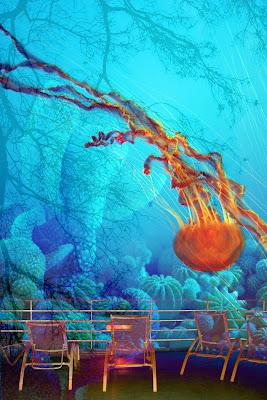2 Open Studio artists make digital art worth seeing
Originally published October 12, 2012 in the Santa Cruz Sentinel
When
I was a journalism student at Fresno State, professor Flynn—a quirky,
straight-talking veteran of both the navy and the Miami Herald—started his
reporting class by drawing a list on the blackboard. Flynn’s “Hierarchy of Writers”
placed poets at the very top. They were the loftiest, most respected of all
writers. Below poets were novelists, playwrights, essayists, advertisers, publicists,
etc., and at the very bottom were reporters, the lowliest of all writers,
commonly associated with the word “hack” if they did it for too long. I did
well in the class, but Flynn’s “Hierarchy” certainly put that into perspective.
 |
| "Celeste" by Bonita Diemoz |
As
a photographer, I have sometimes sensed a similar unspoken ranking for visual
artists. At the very top level are, or course, painters—presumably what all
artists would aspire to be if only they had the talent. Below painters in
significance are sculptors, architects, printmakers, designers and all sorts of
crafts-persons. Photographers are nowhere near the top, and, like journalists,
probably somewhere near the bottom—or maybe even in a category all their own,
separate from art. Why else would photography be excluded from juried art shows,
or share the home arts building with the county fair apple pies and postcard
collections? (To be fair, I hope this
has more to do with the popularity of photography and the volume of entries, rather
than a snub at photography.)
 |
| "Rhoda" by Bonita Diemoz |
Those
led to photography can be just as brilliant and talented as any other artist.
And these days, digital processes have given photographers many more ways of
expressing themselves. In the Open Studios Art Tour calendar for 2012 you’ll
find 38 photographers and 13 digital artists. Some digital artists further
subcategorize their media as collage or mixed media, and print on surfaces as
varied as paper, metal, glass and fabric.
 |
| Bonita Diemoz’s surreal
digitally altered photographs are a treat to see, as well as her beautiful Victorian home in downtown Santa Cruz. |
 |
| "Magdalena" by Bonita Diemoz |
Bonita
Diemoz, who creates digitally altered photographs, will be participating in her
seventh Open Studios Art Tour this year. A former weaver and casual
photographer, she took a digital photography class at Cabrillo College from Ted
Orland about 10 years ago just to learn how to use her new digital camera. But
when she also learned how to use Photoshop, she was hooked. “Once I discovered
what I could do in Photoshop, I found my niche.” she says. “I love it. I spend
hours and hours and hours even though I work fulltime. If I ever get to retire
I’m going to do Photoshop all day long every day.”
Diemoz
describes herself as the “Cemetery Queen.” Her favorite cemeteries are in Italy
and France, where larger-than-life marble statues adorn the graves of the
wealthy. On her website, she shares maps to guide others to Staglieno Cemetery
in Genoa or Montparnasse Cemetery in Paris. “From about the 1880s to about the
1920s there was a real renaissance of people hiring famous sculptors to make
their one-of-a-kind monument,” says Diemoz. “Today, that’s just prohibitively
expensive.”
 |
| "Metamorphosis" by Bonita Diemoz |
 |
| "Rosebud" by Bonita Diemoz |
Over
the years, she has amassed a large collection of statuary imagery from visits
to her favorite cemeteries—angels with impressive wings, lovers kissing, a
mother feeding a baby, a woman sleeping—and has combined these emotive images
with dramatic scenery. Local residents will recognize the cliffs, surf and
beaches along West Cliff Drive as backdrop for many of her photos. The results
are startlingly beautiful and otherworldly, more surreal and romantic than
tragic.
 |
| Linda Cordy’s paintings and
digital collages are displayed in her living room, as she gets ready for Open Studios, with her dog, Bailey. |
 |
| "Jelly" by Linda Cordy |
Cordy
was also a student of Ted Orland’s at Cabrillo College. Her collages are a fascinating
combination of objects and places she’s photographed, and she enjoys pointing
out local elements in her work that people will recognize, such as the roof of
the Rittenhouse Building or the top of the Boardwalk Merry-Go-Round. In
addition to combining layers of her own photographs, she uses digital images of
her paintings to create texture and subject matter. She also scans real objects
such as flowers and feathers for her collages. “I have to go through thousands
of photos. There aren’t many photos you can make collages out of,” says Cordy.
.jpg) |
| "Wonderland" by Linda Cordy |
Much
of Cordy’s work is personal or family-related. She has a large portrait she
painted of her paternal grandmother on the wall of her living room, with words
and phrases floating around her head such as “suffragette,” “union organizer,”
and “seamstress to the queen”—so her legacy would be remembered. Cordy has also
created a digital family tree collage, with biographical photographs of her
relatives. And, above her fireplace is a painting of a seductive scorpion fish—a
personal and political statement, she says, about her bank. “They have my loan
and they have been evil,” she says with a laugh.
.jpg) |
| "Velocity" by Linda Cordy |
.jpg) |
| "Legend" by Linda Cordy |

No comments:
Post a Comment